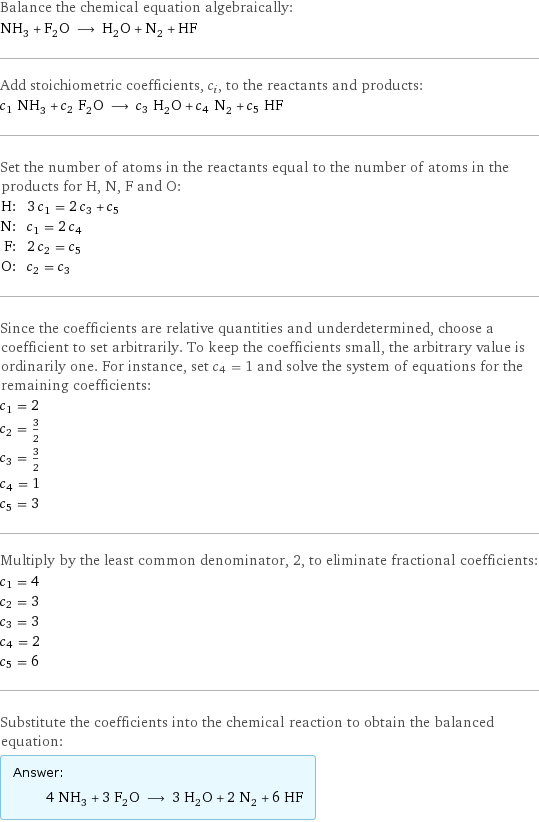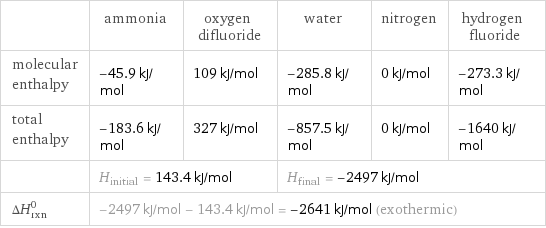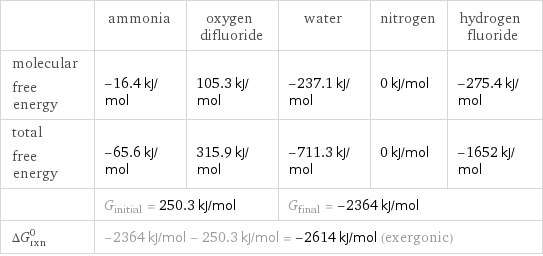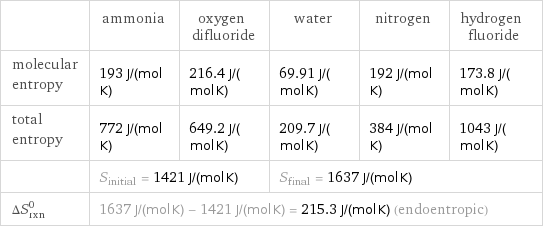Input interpretation

NH_3 ammonia + F_2O oxygen difluoride ⟶ H_2O water + N_2 nitrogen + HF hydrogen fluoride
Balanced equation

Balance the chemical equation algebraically: NH_3 + F_2O ⟶ H_2O + N_2 + HF Add stoichiometric coefficients, c_i, to the reactants and products: c_1 NH_3 + c_2 F_2O ⟶ c_3 H_2O + c_4 N_2 + c_5 HF Set the number of atoms in the reactants equal to the number of atoms in the products for H, N, F and O: H: | 3 c_1 = 2 c_3 + c_5 N: | c_1 = 2 c_4 F: | 2 c_2 = c_5 O: | c_2 = c_3 Since the coefficients are relative quantities and underdetermined, choose a coefficient to set arbitrarily. To keep the coefficients small, the arbitrary value is ordinarily one. For instance, set c_4 = 1 and solve the system of equations for the remaining coefficients: c_1 = 2 c_2 = 3/2 c_3 = 3/2 c_4 = 1 c_5 = 3 Multiply by the least common denominator, 2, to eliminate fractional coefficients: c_1 = 4 c_2 = 3 c_3 = 3 c_4 = 2 c_5 = 6 Substitute the coefficients into the chemical reaction to obtain the balanced equation: Answer: | | 4 NH_3 + 3 F_2O ⟶ 3 H_2O + 2 N_2 + 6 HF
Structures

+ ⟶ + +
Names

ammonia + oxygen difluoride ⟶ water + nitrogen + hydrogen fluoride
Reaction thermodynamics
Enthalpy

| ammonia | oxygen difluoride | water | nitrogen | hydrogen fluoride molecular enthalpy | -45.9 kJ/mol | 109 kJ/mol | -285.8 kJ/mol | 0 kJ/mol | -273.3 kJ/mol total enthalpy | -183.6 kJ/mol | 327 kJ/mol | -857.5 kJ/mol | 0 kJ/mol | -1640 kJ/mol | H_initial = 143.4 kJ/mol | | H_final = -2497 kJ/mol | | ΔH_rxn^0 | -2497 kJ/mol - 143.4 kJ/mol = -2641 kJ/mol (exothermic) | | | |
Gibbs free energy

| ammonia | oxygen difluoride | water | nitrogen | hydrogen fluoride molecular free energy | -16.4 kJ/mol | 105.3 kJ/mol | -237.1 kJ/mol | 0 kJ/mol | -275.4 kJ/mol total free energy | -65.6 kJ/mol | 315.9 kJ/mol | -711.3 kJ/mol | 0 kJ/mol | -1652 kJ/mol | G_initial = 250.3 kJ/mol | | G_final = -2364 kJ/mol | | ΔG_rxn^0 | -2364 kJ/mol - 250.3 kJ/mol = -2614 kJ/mol (exergonic) | | | |
Entropy

| ammonia | oxygen difluoride | water | nitrogen | hydrogen fluoride molecular entropy | 193 J/(mol K) | 216.4 J/(mol K) | 69.91 J/(mol K) | 192 J/(mol K) | 173.8 J/(mol K) total entropy | 772 J/(mol K) | 649.2 J/(mol K) | 209.7 J/(mol K) | 384 J/(mol K) | 1043 J/(mol K) | S_initial = 1421 J/(mol K) | | S_final = 1637 J/(mol K) | | ΔS_rxn^0 | 1637 J/(mol K) - 1421 J/(mol K) = 215.3 J/(mol K) (endoentropic) | | | |
Equilibrium constant
![Construct the equilibrium constant, K, expression for: NH_3 + F_2O ⟶ H_2O + N_2 + HF Plan: • Balance the chemical equation. • Determine the stoichiometric numbers. • Assemble the activity expression for each chemical species. • Use the activity expressions to build the equilibrium constant expression. Write the balanced chemical equation: 4 NH_3 + 3 F_2O ⟶ 3 H_2O + 2 N_2 + 6 HF Assign stoichiometric numbers, ν_i, using the stoichiometric coefficients, c_i, from the balanced chemical equation in the following manner: ν_i = -c_i for reactants and ν_i = c_i for products: chemical species | c_i | ν_i NH_3 | 4 | -4 F_2O | 3 | -3 H_2O | 3 | 3 N_2 | 2 | 2 HF | 6 | 6 Assemble the activity expressions accounting for the state of matter and ν_i: chemical species | c_i | ν_i | activity expression NH_3 | 4 | -4 | ([NH3])^(-4) F_2O | 3 | -3 | ([F2O])^(-3) H_2O | 3 | 3 | ([H2O])^3 N_2 | 2 | 2 | ([N2])^2 HF | 6 | 6 | ([HF])^6 The equilibrium constant symbol in the concentration basis is: K_c Mulitply the activity expressions to arrive at the K_c expression: Answer: | | K_c = ([NH3])^(-4) ([F2O])^(-3) ([H2O])^3 ([N2])^2 ([HF])^6 = (([H2O])^3 ([N2])^2 ([HF])^6)/(([NH3])^4 ([F2O])^3)](../image_source/04bab9b862ff9b7b05cad169ba3444d2.png)
Construct the equilibrium constant, K, expression for: NH_3 + F_2O ⟶ H_2O + N_2 + HF Plan: • Balance the chemical equation. • Determine the stoichiometric numbers. • Assemble the activity expression for each chemical species. • Use the activity expressions to build the equilibrium constant expression. Write the balanced chemical equation: 4 NH_3 + 3 F_2O ⟶ 3 H_2O + 2 N_2 + 6 HF Assign stoichiometric numbers, ν_i, using the stoichiometric coefficients, c_i, from the balanced chemical equation in the following manner: ν_i = -c_i for reactants and ν_i = c_i for products: chemical species | c_i | ν_i NH_3 | 4 | -4 F_2O | 3 | -3 H_2O | 3 | 3 N_2 | 2 | 2 HF | 6 | 6 Assemble the activity expressions accounting for the state of matter and ν_i: chemical species | c_i | ν_i | activity expression NH_3 | 4 | -4 | ([NH3])^(-4) F_2O | 3 | -3 | ([F2O])^(-3) H_2O | 3 | 3 | ([H2O])^3 N_2 | 2 | 2 | ([N2])^2 HF | 6 | 6 | ([HF])^6 The equilibrium constant symbol in the concentration basis is: K_c Mulitply the activity expressions to arrive at the K_c expression: Answer: | | K_c = ([NH3])^(-4) ([F2O])^(-3) ([H2O])^3 ([N2])^2 ([HF])^6 = (([H2O])^3 ([N2])^2 ([HF])^6)/(([NH3])^4 ([F2O])^3)
Rate of reaction
![Construct the rate of reaction expression for: NH_3 + F_2O ⟶ H_2O + N_2 + HF Plan: • Balance the chemical equation. • Determine the stoichiometric numbers. • Assemble the rate term for each chemical species. • Write the rate of reaction expression. Write the balanced chemical equation: 4 NH_3 + 3 F_2O ⟶ 3 H_2O + 2 N_2 + 6 HF Assign stoichiometric numbers, ν_i, using the stoichiometric coefficients, c_i, from the balanced chemical equation in the following manner: ν_i = -c_i for reactants and ν_i = c_i for products: chemical species | c_i | ν_i NH_3 | 4 | -4 F_2O | 3 | -3 H_2O | 3 | 3 N_2 | 2 | 2 HF | 6 | 6 The rate term for each chemical species, B_i, is 1/ν_i(Δ[B_i])/(Δt) where [B_i] is the amount concentration and t is time: chemical species | c_i | ν_i | rate term NH_3 | 4 | -4 | -1/4 (Δ[NH3])/(Δt) F_2O | 3 | -3 | -1/3 (Δ[F2O])/(Δt) H_2O | 3 | 3 | 1/3 (Δ[H2O])/(Δt) N_2 | 2 | 2 | 1/2 (Δ[N2])/(Δt) HF | 6 | 6 | 1/6 (Δ[HF])/(Δt) (for infinitesimal rate of change, replace Δ with d) Set the rate terms equal to each other to arrive at the rate expression: Answer: | | rate = -1/4 (Δ[NH3])/(Δt) = -1/3 (Δ[F2O])/(Δt) = 1/3 (Δ[H2O])/(Δt) = 1/2 (Δ[N2])/(Δt) = 1/6 (Δ[HF])/(Δt) (assuming constant volume and no accumulation of intermediates or side products)](../image_source/759111f6d3a7eb507802f6816dbea042.png)
Construct the rate of reaction expression for: NH_3 + F_2O ⟶ H_2O + N_2 + HF Plan: • Balance the chemical equation. • Determine the stoichiometric numbers. • Assemble the rate term for each chemical species. • Write the rate of reaction expression. Write the balanced chemical equation: 4 NH_3 + 3 F_2O ⟶ 3 H_2O + 2 N_2 + 6 HF Assign stoichiometric numbers, ν_i, using the stoichiometric coefficients, c_i, from the balanced chemical equation in the following manner: ν_i = -c_i for reactants and ν_i = c_i for products: chemical species | c_i | ν_i NH_3 | 4 | -4 F_2O | 3 | -3 H_2O | 3 | 3 N_2 | 2 | 2 HF | 6 | 6 The rate term for each chemical species, B_i, is 1/ν_i(Δ[B_i])/(Δt) where [B_i] is the amount concentration and t is time: chemical species | c_i | ν_i | rate term NH_3 | 4 | -4 | -1/4 (Δ[NH3])/(Δt) F_2O | 3 | -3 | -1/3 (Δ[F2O])/(Δt) H_2O | 3 | 3 | 1/3 (Δ[H2O])/(Δt) N_2 | 2 | 2 | 1/2 (Δ[N2])/(Δt) HF | 6 | 6 | 1/6 (Δ[HF])/(Δt) (for infinitesimal rate of change, replace Δ with d) Set the rate terms equal to each other to arrive at the rate expression: Answer: | | rate = -1/4 (Δ[NH3])/(Δt) = -1/3 (Δ[F2O])/(Δt) = 1/3 (Δ[H2O])/(Δt) = 1/2 (Δ[N2])/(Δt) = 1/6 (Δ[HF])/(Δt) (assuming constant volume and no accumulation of intermediates or side products)
Chemical names and formulas

| ammonia | oxygen difluoride | water | nitrogen | hydrogen fluoride formula | NH_3 | F_2O | H_2O | N_2 | HF Hill formula | H_3N | F_2O | H_2O | N_2 | FH name | ammonia | oxygen difluoride | water | nitrogen | hydrogen fluoride IUPAC name | ammonia | fluoro hypofluorite | water | molecular nitrogen | hydrogen fluoride